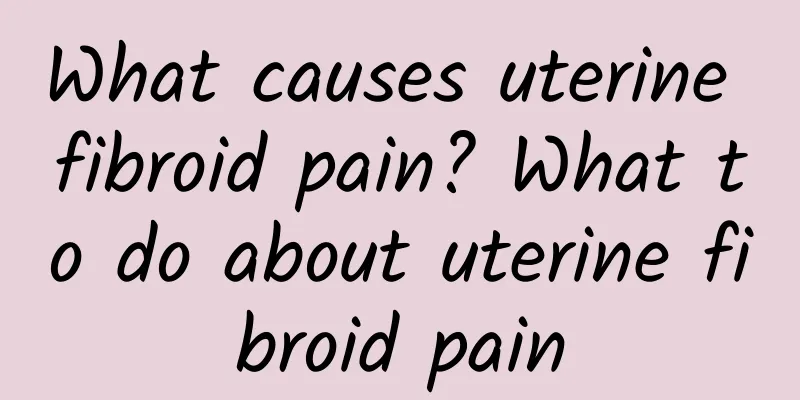What are the procedures for hysterectomy? What are the preparations for hysterectomy?

|
What are the procedures for hysterectomy? What are the preparations for hysterectomy? Uterine fibroids are one of the most common benign tumors in gynecology. For some patients with severe symptoms or those whose quality of life is affected, they may need to consider uterine fibroid removal surgery. So, what should be done and what preparations should be made before uterine fibroid removal surgery? This article will answer your questions one by one. 1. Preoperative examination items Before undergoing uterine myomectomy, a series of preoperative examinations are required to ensure that the patient's physical condition is suitable for surgery. Common preoperative examination items include: 1. Gynecological examination: Gynecological examination is an important method to determine the size, number and location of uterine fibroids. Through vaginal examination and cervicoscopy, doctors can understand the specific situation of fibroids and provide reference for surgery. 2. Color Doppler Ultrasound Examination: Color Doppler Ultrasound is a non-invasive, non-radiation examination method that can clearly show the size, number and location of uterine fibroids. Doctors can use color doppler ultrasound examination to determine the method and plan of surgery. 3. Blood test: Blood test can understand the patient's blood routine, blood type, coagulation function and other indicators to assess the patient's surgical risks. 2. Preparation for surgery After deciding to perform uterine myomectomy, some surgical preparations are required to ensure the smooth progress of the operation. Common surgical preparations include: 1. Fasting before surgery: It is generally necessary to fast for more than 8 hours before surgery to ensure that the patient's gastrointestinal tract is empty and reduce the risk of complications during surgery. 2. Electrocardiogram: Electrocardiogram is an important means to evaluate the patient's heart function. Through electrocardiogram, we can understand whether the patient has heart disease and provide reference for surgery. 3. Arrange hospitalization: For some patients with larger fibroids or other serious symptoms, hospitalization is required for surgery. Hospitalization can ensure that patients receive timely care and observation after surgery. 3. Related issues of uterine myomectomy Before undergoing myomectomy, patients may have some questions. Here are answers to some common questions: 1. Is myomectomy painful? Myomectomy is usually performed under general anesthesia, and the patient will not feel pain during the operation. There may be mild pain and discomfort after the operation, but it can be relieved by medication. 2. What is the recovery period like after surgery? After myomectomy, patients need to rest for a period of time and avoid strenuous exercise and fatigue. After surgery, doctors will give relevant guidance based on the patient's specific situation to promote recovery. 3. Will the operation affect fertility? Myomectomy itself will not affect fertility, but some patients may need to undergo hysteroscopy before surgery or a certain area of uterine muscle layer may need to be removed when removing myomas, which may have some impact on the structure of the uterus and there is a certain possibility of postoperative recurrence. Therefore, if you want to get pregnant after surgery, you must follow the doctor's advice for relevant monitoring and treatment. Summarize: Myomectomy is an effective treatment for uterine fibroids. Preoperative examinations and surgical preparations are all to ensure the success of the operation and the safety of the patient. Patients should maintain a positive attitude before surgery and perform relevant surgical preparations under the guidance of the doctor to ensure the smooth progress of the operation. At the same time, the postoperative recovery period also requires patients to pay attention to rest and follow the doctor's advice to promote early healing of the wound. |
<<: What are the dangers of malignant uterine fibroids? Are malignant uterine fibroids serious?
Recommend
What Chinese medicine is better for endometriosis?
What are the traditional Chinese medicines for tr...
What kind of diet is beneficial for the treatment of female ovarian cysts
Many patients with ovarian cysts are not very cle...
Small amounts of exercise can still help improve brain function
Exercise has many benefits for the body, but ther...
A Suzhou-style mooncake contains a lot of oil, which takes 20,000 steps to burn.
During the Mid-Autumn Festival, when families cel...
What are the causes of ectopic pregnancy?
Ectopic pregnancy is a dangerous acute gynecologi...
Interval walking is more powerful for exercising thighs and improving muscle endurance
Are you still doing the same old normal walking? ...
How is hydatidiform mole detected?
I believe that many female friends have heard doc...
What is vulvar itching?
Vulvar itching is a disease that makes women extr...
How to use medicine for pelvic inflammatory disease
How to use medicine for pelvic inflammatory disea...
Fever is actually a very common symptom of pelvic inflammatory disease.
In medicine, pelvic inflammatory disease is divid...
Experts explain the causes of moderate cervical erosion
It is very necessary for patients with moderate c...
Genetic diseases that cause miscarriage
Genetic diseases that cause miscarriage can be pr...
Causes of chronic pelvic inflammatory disease
Causes of chronic pelvic inflammatory disease: Ch...
What should I do if my daughter has irregular menstruation?
What should I do if my daughter has irregular men...
Which is more harmful, artificial abortion or medical abortion? Comparison of artificial abortion and medical abortion in four aspects
Surgical abortion and medical abortion are both v...









